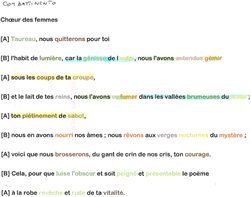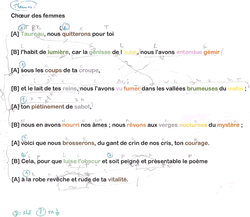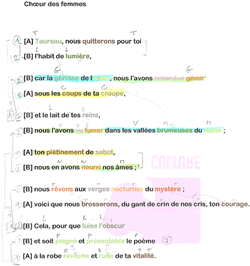Acousmatic Music: Continuity or Rupture?
Translated and edited from the original presentation entitled “Musique acousmatique : continuité ou rupture ?” by David Ogborn.
Despite the radically different means and language used, I will try to place certain of my works in the continuity of musical history. In Ce qu’a vu le vent d’Est, I am listening to Debussy with a new ear, while the acousmatic opera yawar fiesta is a form of madrigalism in space, and through sound images.
In the France of the twentieth century, Pierre Schaeffer overturns perceptual habits (four types of listening, sound as form and as material) as well as descriptive conventions (the totality of sound appears in the typo-morphology of the Treatise on Musical Objects). François Bayle develops theoretical concepts related to acousmatic music — music produced and then heard by means of loudspeakers (the sound image, guided listening, an archetypal relationship to memory, space, the acousmatic method of creation in the studio). Of course, this is accompanied by a technological revolution (sound recording, real-time processing, synthesis…). It is a break with the past, therefore.
However, the historical link can be maintained. A morpho-dynamic listening can be applied to melodic-harmonic writing, resulting in a renewed perceptual analysis of the style of certain composers. From this standpoint, the study of Debussy allowed me to expand the range of my writing in sound, like the painters who would set up their easels in the Louvre to study by copying the old styles.
On the other hand, the habit of thinking of music as a conduit for the imagination of the listener, through hierarchical layers of signs (Charles Pierce) among other things, leads to an interaction with the original text. In composing the electroacoustic opera yawar fiesta I am returning to the madrigalesque relationships of Gesualdo or Monteverdi — by the use, among other things, of figurative motions in space, and starting from singers’ improvisations in the studio.
Ce qu’a vu le vent d’Est (after Debussy)
A mental image was the background to the composition — the image of “Desert Storm” (1991). With an acousmatic approach, granular materials are like sand. A structure of layers and opaque or transparent curtains relates to the history of Iraq, with its superimposed layers of different civilizations.
In Debussy, there is a research of timbre, a relationship with nature, and a “montage” construction built out of cells, like in the cinema. I study his style in Dialogue du vent et de la mer (third movement of La mer), Ce qu’a vu le vent d’ouest, Jeux, and the orchestral interludes in Pelléas et Mélisande. With a Schaeffer-like ear one hears morphologies, energies/motions, montage, contrasts, amplifications, tension/relaxation, repetitions, and transitions. By comparing Dialogue (8 minutes) and Vent d’ouest (2:30 stretched out to 8 minutes), I note the same proportional temporal structure, in three waves of tension and relaxation, finishing with the same “comma” at the highpoint of the wave.
Debussy as a Temporal Model
I apply temporal compression to the tensions, and dilation to the relaxations, with or without transposition, in an independent manner, and then in a coordinated manner, for the two works. This is used as a temporal model on which layers of granular matter are superimposed, masking or letting through a few gusts of Debussy.
The Study of Style — Some Examples
Contrast between texture and movement: figures in movement against a static background.
Amplification in waves of larger and larger mass, and/or accelerated tempo, and/or increased register.
Repetition whose persistence creates tension. Repetition/tension that prepares for the arrival of a new event.
Transition by repetition of a cell transposed upwards, often accelerated, only to fall in the following, lower-pitched, event (or vice versa).
Transition by fade-in/fade-out of colours.
Transition by a breakaway articulation.
Energetic and temporal model: temporal dilation/contraction of Dialogue and Vent d’ouest.
Treatment (towards a shower of coloured grains), dilation of relaxations/suspensions, tightening of the tensions, and mixture.
Layers of granular matter (the sand…) in the form of waves.
Dialogues between all the waves, having the general structure of Debussy’s waves as a temporal background, which appear in fleeting gusts from behind the curtain of matter that covers them.
yawar fiesta, an Acousmatic Opera
Libretto by Werner Lambersy, with bass Nicolas Ischerwood, contraltos Fadila Figuidi and Annette Vande Gorne, soprano Françoise Vanhecke, and reciters Werner Lambersy and Charles Kleinberg.
Starting with a semiological analysis: indicating the relationships between words by colour codes.


A series of themes follow from this:
- Power, money, crushing, earth, enclosure, images, external strength;
- Poverty, void, liberty, sky, space, renunciation, fragility, inner strength;
- Defence against the spectacle of power by laughter, derision;
- Words of truth, the scribe as witness, a deserted and desert poem;
- Living in the moment, living is a miracle, passing time, the eternal cycle of life;
- Incessant inner struggle: we are at once victorious over and defeated by ourselves, shadow and light;
- Unity through collective rite, dance, games.
These themes generate a series of sound patterns, like leitmotifs. Their relationship to the text is usually madrigal-like, through the archetypal sound images that underpin them, and the mental images they engender.

Formal principles also follow, applicable both on the local level of a phrase or a section, and on the more global level of an act or the whole opera:
- opposition, duality;
- mirror symmetry or correspondence: Combattimento (Act II) “sous les coups de ta croupe /et le lait de tes reins”;
- alternation: Monologue final: ce qui se passe ici;
- chiasmus;
- thesis (Act I), antithesis (Act II), synthesis (Monologue final).

The end of the opera (which is a kind of “moral” and is not intended to be represented on the stage) gives an overall summary of the themes. Therefore, I am starting at the end (cf. Jean Absil) and generating a series of thematic materials (leitmotifs). The majority of this material is of vocal origin: the narrators or singers are recorded while improvising in the studio (a “concrete” approach).
There will be no singers on stage, only mimes/dancers. The work is treated in the incantatory manner of Aeschylus’ tragedies, using few characters (choryphaeus), and underlining the importance of the chorus. A universal subject.
Space, polyphonic spatial movements and the choice of matter and the sound treatments for their character full of imagery establish a madrigal-like relationship with the text. Singing is also reintroduced into this electroacoustic music, for its lyrical expressivity (polyphony or colour-chords).
Social top